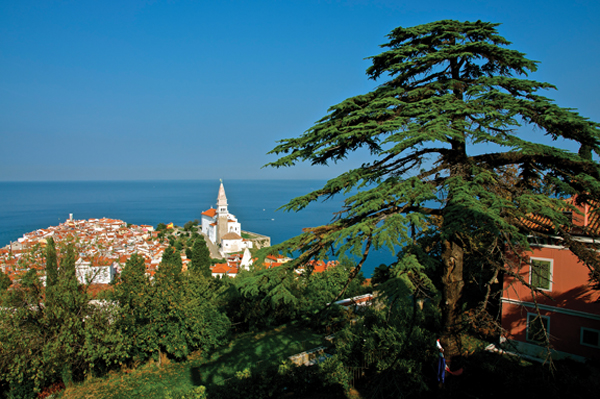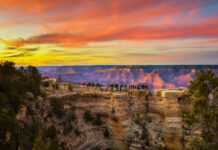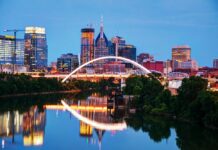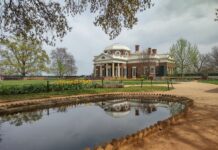On a sunny September afternoon three years ago, my wife and I sat on a veranda overlooking Slovenia’s Lake Bled, noshing on a slab of local cream cake. Not the prettiest named locale, I admit—does Dracula do a timeshare here?— but this historic resort area offers a fairy-tale setting of fantastical beauty.
A soaring rock cliff abuts the lake, atop of which perches, however improbably, the towers and turrets of a 15th-century castle. A leafy island floats amid the cerulean blue waters—this land mass is barely large enough to hold the Church of the Assumption, a Baroque confection outfitted with an oft-pealing bell tower. Rustic wooden rowboats with jaunty, striped canopies sail the crystalline waters, along with swans. And looming over and around all are the green or snow-streaked peaks of the Julian Alps, as if embracing the scene as a hidden, once-upon-a-timerealm.
If you don’t believe me, just ask Donald Trump.
OK, I’m not sure how much time he spent looking out the window back in 2002 when he met his future in-laws in the dining room of the resort’s Grand Hotel Toplice. His then-girlfriend, now third wife, Melania Trump (nee Melanija Knavs), is Slovenian. I read that The Donald sipped a Diet Coke during the brief, meet-the-folks moment and, by way of parting, inquired if the hotel was for sale. Trump was soon back aboard his branded 727, winding up his one-and-only visit to Slovenia in a crisp three hours.
In contrast, we spent nearly two weeks in this clean, green gem of South Central Europe, after learning of its virtues from a Slovenian friend. Our biggest problem was gushing about it upon our return and being met with myriad variations of: “Oh, so Slovakia is that cool, huh?” So say what you will about Melania, the fashion-model-turned-potential-First Lady has helped Slovenia garner more media attention in the past six months than the previous 25 years. Hopefully this translates into fewer Americans confusing it—the northern-most part of the former Yugoslavia—with its Slavic cousin, the eastern half of the former Czechoslovakia.
Whether or not Slovenia gets a tourist bump out of all this remains to be seen. But let me do my part: You should go to Slovenia. If Maryland is dubbed “America in miniature” for its diverse landscapes, then Slovenia is “Europe in miniature.” It’s some two million people in a nation smaller than New Hampshire, where an afternoon’s train ride takes you from The Sound of Music’s Alpine mountainscapes to an Italianesque Adriatic coast of jumbled, red-tile roofs and sun-blanched churches. Slovenia has friendly residents, a cozy capital city, great food and wine, plenty of English speakers and far fewer opportunities to get poked by a selfie-stick from mobs of bus-born tourists.
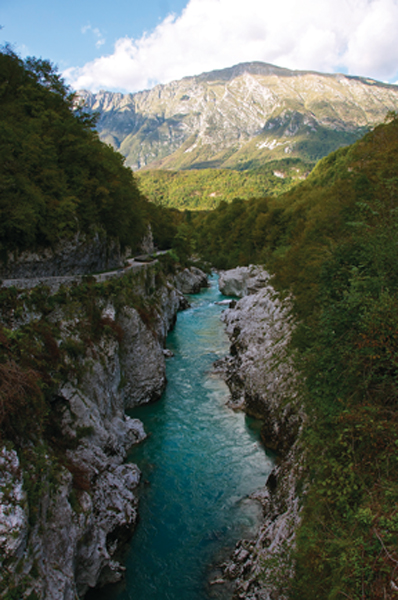 Let’s start with the capital and largest city, Ljubljana. Yeah, OK, while Slovakia’s capital, Bratislava, is easy to pronounce, to English-speaking tongues this puzzle of Ls and Js can be daunting. It’s loo-blee-ah-nuh, the charming home to barely 300,000 souls and one of Europe’s smallest capitals—an asset, not a drawback. It’s leafy and compact, nestled under a hilltop castle and bisected by the meandering, café-lined Ljubljanica River. Rugged mountains can be seen in the near distance.
Let’s start with the capital and largest city, Ljubljana. Yeah, OK, while Slovakia’s capital, Bratislava, is easy to pronounce, to English-speaking tongues this puzzle of Ls and Js can be daunting. It’s loo-blee-ah-nuh, the charming home to barely 300,000 souls and one of Europe’s smallest capitals—an asset, not a drawback. It’s leafy and compact, nestled under a hilltop castle and bisected by the meandering, café-lined Ljubljanica River. Rugged mountains can be seen in the near distance.
It took us only a day of wandering about to get the lay of the land and feel at home in Ljubljana. (Try that with London or Madrid.) We easily settled into the sidewalk café scene, people-watching over pivo (beer) or vino. Architecturally, the city boasts some Baroque gems and even the remains of Roman walls, but most striking are the many fancifully painted Art Nouveau buildings erected in the wake of an 1895 earthquake.
We were among the first to take a recently launched food tour for a four-hour trek through the city’s heart and stomach. (And the Top Ljubljana Foods tour is still going strong.) Traditional Slovene food tends to be porky, but the proximity of the Adriatic means we also enjoyed grilled seafood on a riverside patio. A taste of the Balkans came from a Muslim-run eatery offering Bosnian grilled beef, and we ended up with sweets and wine atop an Art Deco high-rise.
With all the eating and drinking, it’s just as well that Lake Bled was our next stop. We got busy rowing a rented boat out to the island church and walking the four-mile lake perimeter. While strolling the shore, be sure to detour up Osojnica Hill, following signage along a steep trail to the perfect photo perch.
Another famous American connected to Slovenia is Ernest Hemingway, who set some climactic parts of A Farewell to Arms in our next destination, Kobarid, in the stunning Soča River Valley. Only in Papa’s day it was called Caporetto and part of Italy. And the scene was stunningly grim. Italian forces were routed here as Austro-Hungarian troops poured through the mountains, causing one the most ignoble and bloody retreats in World War I.
Nearly a century later, the town slumbers peacefully. A multi-story museum brings the battle to graphic life, but we soon longed to be outside. A strenuous day’s hike began from the steps of the sternly fascistic charnel house Mussolini had built for storing Italian war dead. Into the mountains we climbed, passing through vestigial trenches and redoubts, but mostly enjoying the natural beauty. The star of the show is the Soča River itself, which we crisscrossed—once on a scary swinging bridge, and then via the stone Napoleon Bridge (he invaded here, too). A preponderance of native limestone leaves the water the sort of turquoise we hadn’t seen since Bermuda.
With a scant 30 miles of coastline, Slovenia barely dips a toe into the Adriatic. But what a toe it is! As we headed there next on the train, the scenery soon swapped the this-could-be-Austria look for the balmy Mediterranean—vineyards, olive groves, hilltop towns, even palm trees. We joke that should we ever acquire even a smidgen of Trump-level wealth, we’ll retire to Piran, the jewel of the Slovenian coast. For 500 years, the former Pirano was part of the Venetian Republic and it still wouldn’t look out of place on the other side of Adriatic. (Venice, itself, is only 60 miles away.) It’s a wedge-shaped peninsula heaped with tile-roofed houses connected by a medieval labyrinth of crazy-narrow streets.
No sandy beaches here, but folks readily swim the clear waters from the seawall boulders. The hills on the landward side sport walkable, crenulated walls, vestiges of fortifications begun in the 7th century. The town’s heart is Tartini Square, named for native son, composer/musician Giuseppe Tartini, whose statue watches over it. One dusk, as we sat at a nearby café sipping local malvasia wine, the square was filled with local children running and playing. How nice to see a gorgeous and historic setting that’s actually lived in, and not another dead postcard.
We stayed at Miracolo di Mare, a friendly, family-run B&B in the old town where breakfast is served in the backyard garden beneath an arbor of kiwi vines. (And it’s still a TripAdvisor darling.) We used their free loaner bikes to explore the coast, pedaling through the so-called Slovenian Riviera, a brief series of glitzy hotels and Euro-beaches (think old men in Speedos), to explore a hilltop sculpture garden at Seča Park. Monolithic, modern stone artworks by international artists have been assembling here since well back into Yugoslavian days. We could see Croatia from up high, and we’d see much more as we spent four days in a rental car exploring that country’s rustic Istria Peninsula before flying back out of Ljubljana.
We never made it to Melania’s hometown of Novo Mesto, but there’s still plenty to see in Slovenia, and we do plan to return. But before that, we’re thinking of going to Slovakia. You know, just to mess with people.
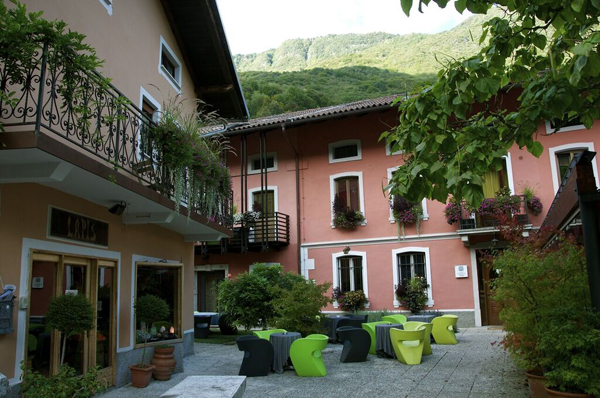 Life in the Slo Lane
Life in the Slo Lane
Where to Stay: Hiša Franko, a chic guesthouse in a mountain valley outside Kobarid, will set you back some Euros. (We splurged for my 50th.) It’s co-owned by jet-setting Slovene chef Ana Ros (seen on Netflix’s “Chef’s Table”), and her adjacent restaurant offers tasting menu-only rips through the cutting-edge of locavore gastronomy. hisafranko.com
Where to Eat: Ladja Podlanica is a boat-cum-restaurant in Piran harbor with no signage saying it’s an eatery. But clamber aboard anyway, take a seat at a picnic table on the stern and prepare for freshness. The house (boat?) wine comes out of a vat and dinner comes out of a bucket of whatever fish they caught that day.
What to Drink: Union and Laško brands dominate the beer scene with serviceable lagers, but seek out the craft offerings from Ljubljana’s Human Fish Brewery. And Slovenian wine is so good, Slovenes like to say, they drink it all themselves, leaving little to export. The malvasia white was our top favorite.
What to See: Vintgar Gorge: A quickie bus ride from Bled, this nearly mile-long series of wooden ramps and bridges takes you up close and personal with a blue water stream roaring down a rocky gorge. A marked trail at the end allows you to hike back to Bled through hushed forests and pristine Alpine villages.


